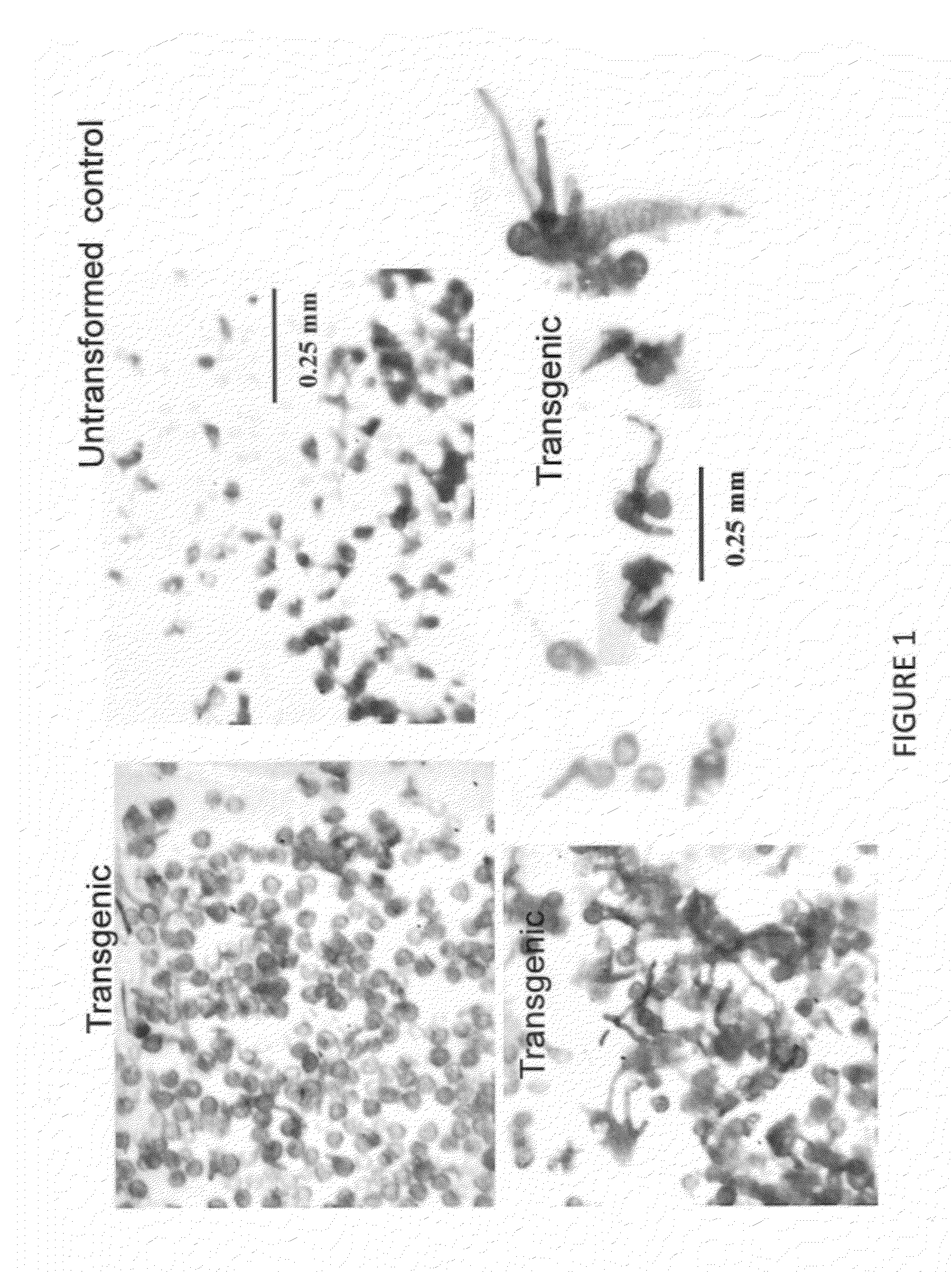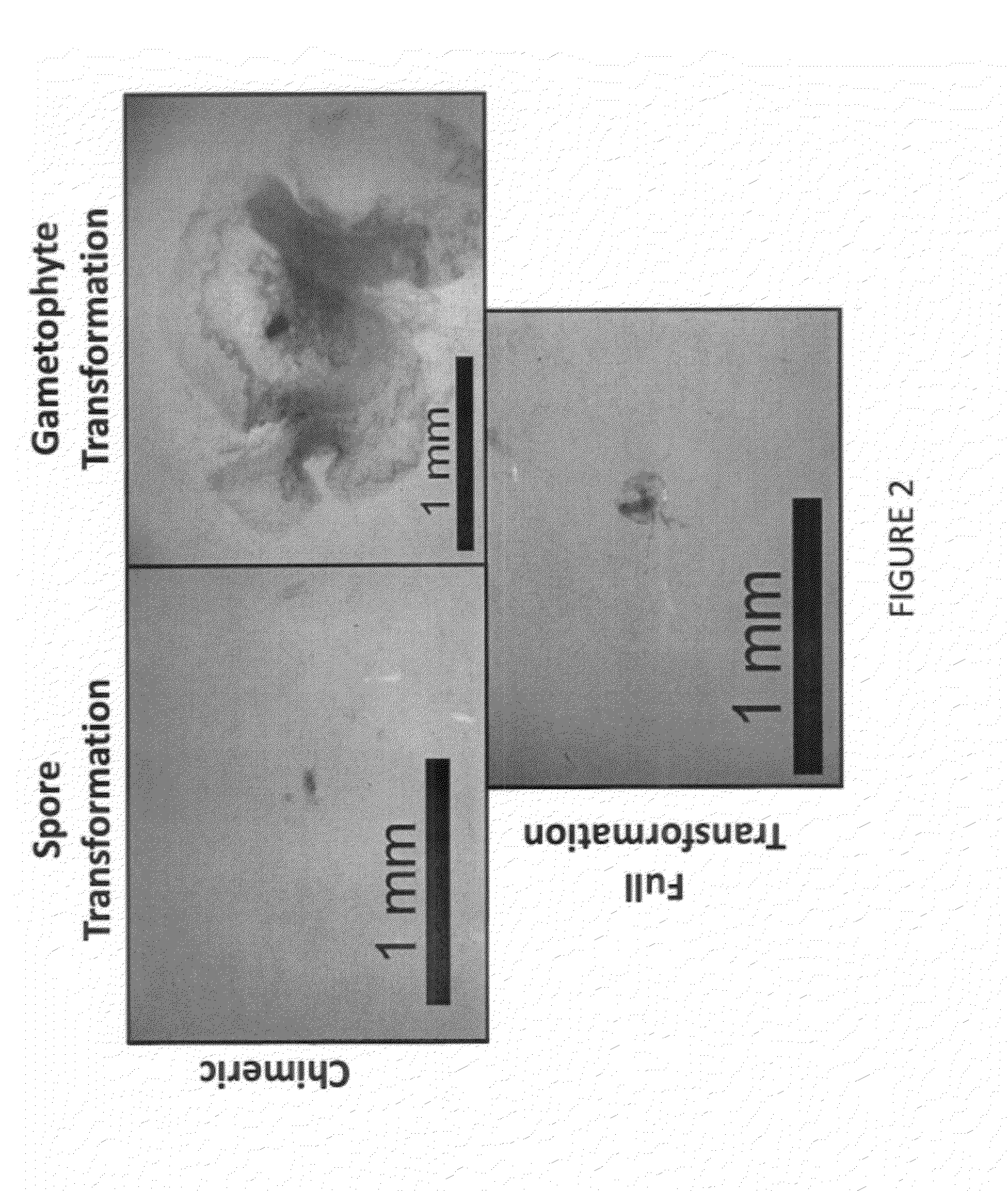Stably transformed ferns and related methods
a technology of ferns and fern leaves, applied in the field of stably transformed ferns, can solve the problems of small size and difficult study
- Summary
- Abstract
- Description
- Claims
- Application Information
AI Technical Summary
Benefits of technology
Problems solved by technology
Method used
Image
Examples
example 1
Actin Promoter Isolation and Vector Construction
[0054]The P. vittata actin gene was isolated from genomic DNA using conserved degenerate primers which were conserved across ferns (Selaginella apoda), marine algae, and angiosperms (forward primer-5′-ATGGCNGAYGGNGARGA-3′ (SEQ ID NO:3) ; and reverse primer-5′-GAAGCAYTTGCGRTGSACRAT-3′ (SEQ ID NO:4)). After confirming the actin gene isolation by sequence analyses, the 5′ upstream region was isolated by two step genome walking using the universal Genomewalker™ kit (Clontech, Mountain View Calif.). A 900 by fragment upstream to actin CDS was used as a promoter to drive the expression of a beta-glucuronidase reporter gene GUSPlus (pCAMBIA1305.2 Genbank Accession No. AF354046) such that the promoter drives expression of a transcript comprising a rice glycine rich protein (GRP) signal peptide, a catalase intron, and a beta-glucuronidase reporter gene isolated isolated from a Staphylococcus sp. The actin promoter and GUSPlus were subcloned int...
example 2
A. tumefaciens Transformation of P. vittata Spores
[0055]Spores were cleaned through 60 micron nylon mesh and surface sterilized in 2.5% bleach containing about 0.4% (v / v) of Tween-20 for five minutes and washed in sterile water for five times using a table top centrifuge (13,000 rpm for 1 min for each wash). The spores were suspended in 0.5 ml 1.5% CMC (carboxy methyl cellulose low viscosity). The approximate spore concentration was 5,000 spores ml−1.
[0056]A 2 ml seed culture of Agrobacterium comprising the binary Agrobacterium transformation vector was started in Agrobacterium growth medium with required antibiotics. In these experiments, the Agrobacterium growth medium comprised KPO4 buffer, MN buffer (MgSO4, NaCl), CaCl2, FeSO4, salts (H3BO3, ZnSO4, CuSO4, MnSO4, Na2MoO4), NH4NO3, 0.5% glycerol (final con), MES and glucose, which is a media that was described by Utermark and Karlovsky 2008. In contrast, Utermark and Karlovsky used LB media to culture Agrobacterium. In the evening...
example 3
Full and Chimeric Transformation of P. vittata Spore and Prothalli Using Biolistic Bombardment
[0059]Spores were cleaned through 60 micron nylon mesh and surface sterilized in 2.5% bleach for one minute, 75% ethanol for one minute, and washed in sterile water three times using a table top centrifuge (13,000 rpm for 1 min for each wash). The spore suspension was plated as 25 μl (˜300 spores plate−1) aliquots on top of hydrophilic PVDF membrane in co-cultivation agar plates comprising ½ Murashige and Skoog (MS) salts+20 g sucrose plates containing 400 mg L-1 timentin. Pteris vittata fronds and Nicotiana tabacum cv. Xanthi leaf controls were also arranged in the same area at the center of medium plates containing only agar. Gold particles (0.6 μm) were sterilized in 100% ethanol and then vector DNA was bound to the gold using CaCl2 and spermidine. The vector used for transformation was pGW501 with a dual (2×) 35S Cauliflower mosaic virus (CaMV) promoter driving the gusA beta-glucuronida...
PUM
| Property | Measurement | Unit |
|---|---|---|
| pH | aaaaa | aaaaa |
| v/v | aaaaa | aaaaa |
| OD | aaaaa | aaaaa |
Abstract
Description
Claims
Application Information
 Login to View More
Login to View More - R&D
- Intellectual Property
- Life Sciences
- Materials
- Tech Scout
- Unparalleled Data Quality
- Higher Quality Content
- 60% Fewer Hallucinations
Browse by: Latest US Patents, China's latest patents, Technical Efficacy Thesaurus, Application Domain, Technology Topic, Popular Technical Reports.
© 2025 PatSnap. All rights reserved.Legal|Privacy policy|Modern Slavery Act Transparency Statement|Sitemap|About US| Contact US: help@patsnap.com



